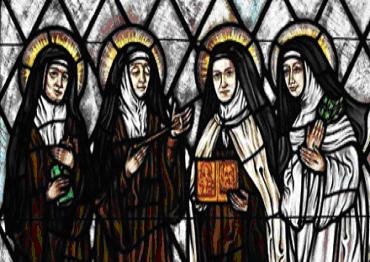 What does the Catholic Church mean by “Saint”? The Catholic Church calls some people “saint” in an official way because they offer exemplary model to the rest of us as to how to be open to God; how to say “yes to God. At first saints were proclaimed by popular acclamation. When a holy person died, the people of the local area would begin calling him or her a saint and, over time, these saints were understood to be particularly good witnesses to living the Christian life.
What does the Catholic Church mean by “Saint”? The Catholic Church calls some people “saint” in an official way because they offer exemplary model to the rest of us as to how to be open to God; how to say “yes to God. At first saints were proclaimed by popular acclamation. When a holy person died, the people of the local area would begin calling him or her a saint and, over time, these saints were understood to be particularly good witnesses to living the Christian life.
Towards the end of the first millennium, popes started proclaiming certain holy people saints by papal decree; this was to ensure a more authoritative process and decision. The canonization of St. Udalric by Pope John XV in 993 is likely one of the first examples of a papal canonization. By 1170, Pope Alexander III had reserved the prerogative of canonizing saints to the pope, a decision confirmed by Pope Innocent III in 1200. Over the years, the process for canonizing a saint became more and more complicated. However, in 1983, Pope John Paul II simplified the process. As a result, the rate of canonizations has increased significantly, giving the Church an even wider group of men and women who can be venerated as saints.
The process of naming a person as a saint of the Church is a long one and involves the following steps:
- When a person has been dead for at least five years, the bishop of his or her local diocese conducts an initial investigation of his or her life and can declare the person a Servant of God. The bishop sends a proposal to the Congregation for the Cause of Canonization of Saints in Rome.
- After an initial investigation into the life of the Servant of God, the Congregation can recommend to the pope that he or she be declared “heroically virtuous.” This is an acclamation that this particular Servant of God displayed Christian virtues and lived the Christian life in a way that is extraordinary. At this point, the person is called “Venerable.”
- The next step is beatification. If the person was a martyr – someone who died for his or her faith – the pope can declare that he or she is “Blessed” and that the church can take as a matter of faith that this person is among the blessed in heaven. If the person was not a martyr, the Congregation searches for evidence of an intercessory miracle; when one is discovered, the pope can declare the person “Blessed.” Those who have been beatified can be included on the list of saints venerated by the local communities that proposed them.
- The final step in the process is canonization. At this stage, the Congregation searches for evidence of a second intercessory miracle. When one is discovered, the person can be canonized and called “Saint.” He or she is added to the list of saints venerated by the world-wide Church.

